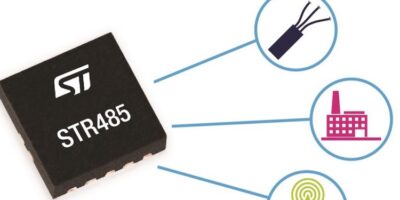Providing an external pin to select 20Mb its per second or 250kbits per second communication, the STR485LV is a 3.3V transceiver for RS485[1] applications that interfaces directly with low-voltage logic down to 1.8V.
The user-selectable data rate allows designers to specify the same device, simplifying inventory management for RS485-networking applications, ranging from high-speed/short-range up to the maximum communication distance (4,000 feet) depending on cable performance. The transceiver is suitable for telecomms infrastructure, high-speed data links, or low-voltage microcontroller communications.
Low voltage logic devices from 1.8V to 3.3V can be connected directly, without needing level-shifting components, advises ST Microelectronics, leveraging the 1.65 to 3.6V supply voltage range for data and enable signals. By maintaining internal driver-output resistance above 96Ohms up to 105 degrees C, the STR485 allows up to 256 transceivers on the same bus in accordance with the RS485 specification.
Features include thermal shutdown to prevent bus contention or faults causing excessive power consumption, and a receiver failsafe mode that prevents errors if inputs are idle, shorted, or unconnected. The bus pins withstand over ±8kV contact discharge and ±16kV air discharge without latch-up, exceeding IEC 61000-4-2 specifications, and are resistant to IEC61000-4-4 fast transient burst class-B.
Packaged as a 3.0 x 3m.0m DFN10, the STR485 has flow-through logic-to-bus pinning that simplifies board design, adds ST Microelectronics.






